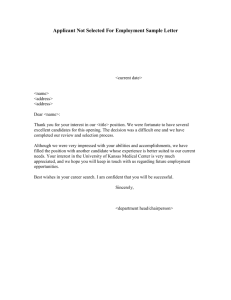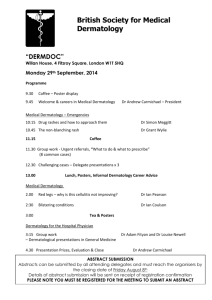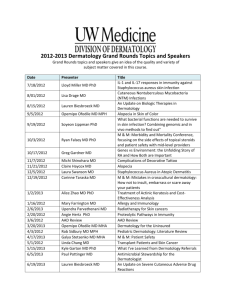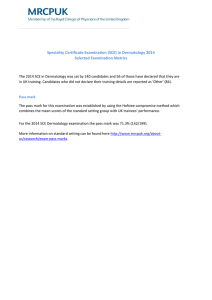Medicine and dermatology in less fortunate countries: a personal
advertisement
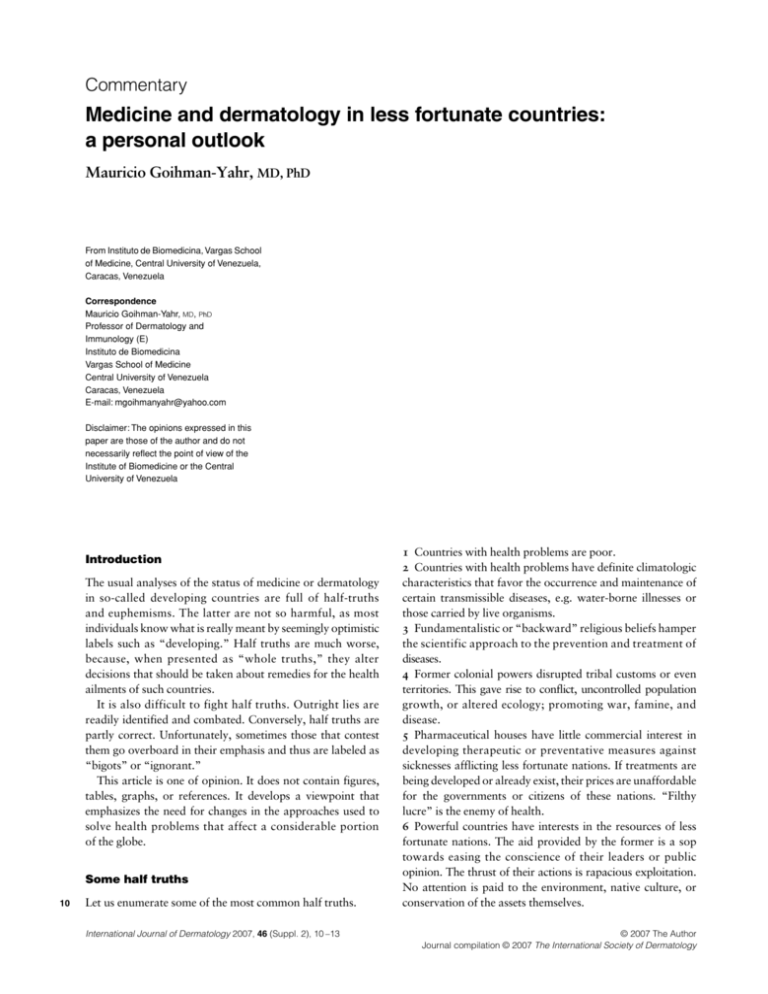
Commentary Oxford, UK International IJD Blackwell 0011-9059 XXX Publishing Journal Ltd Ltd, of Dermatology 2007 Medicine and dermatology in less fortunate countries: a personal outlook Medicine Commentary Goihman-Yahr and dermatology in less fortunate countries Mauricio Goihman-Yahr, MD, PhD From Instituto de Biomedicina, Vargas School of Medicine, Central University of Venezuela, Caracas, Venezuela Correspondence Mauricio Goihman-Yahr, MD, PhD Professor of Dermatology and Immunology (E) Instituto de Biomedicina Vargas School of Medicine Central University of Venezuela Caracas, Venezuela E-mail: mgoihmanyahr@yahoo.com Disclaimer: The opinions expressed in this paper are those of the author and do not necessarily reflect the point of view of the Institute of Biomedicine or the Central University of Venezuela Introduction The usual analyses of the status of medicine or dermatology in so-called developing countries are full of half-truths and euphemisms. The latter are not so harmful, as most individuals know what is really meant by seemingly optimistic labels such as “developing.” Half truths are much worse, because, when presented as “whole truths,” they alter decisions that should be taken about remedies for the health ailments of such countries. It is also difficult to fight half truths. Outright lies are readily identified and combated. Conversely, half truths are partly correct. Unfortunately, sometimes those that contest them go overboard in their emphasis and thus are labeled as “bigots” or “ignorant.” This article is one of opinion. It does not contain figures, tables, graphs, or references. It develops a viewpoint that emphasizes the need for changes in the approaches used to solve health problems that affect a considerable portion of the globe. Some half truths 10 Let us enumerate some of the most common half truths. International Journal of Dermatology 2007, 46 (Suppl. 2), 10 –13 1 Countries with health problems are poor. 2 Countries with health problems have definite climatologic characteristics that favor the occurrence and maintenance of certain transmissible diseases, e.g. water-borne illnesses or those carried by live organisms. 3 Fundamentalistic or “backward” religious beliefs hamper the scientific approach to the prevention and treatment of diseases. 4 Former colonial powers disrupted tribal customs or even territories. This gave rise to conflict, uncontrolled population growth, or altered ecology; promoting war, famine, and disease. 5 Pharmaceutical houses have little commercial interest in developing therapeutic or preventative measures against sicknesses afflicting less fortunate nations. If treatments are being developed or already exist, their prices are unaffordable for the governments or citizens of these nations. “Filthy lucre” is the enemy of health. 6 Powerful countries have interests in the resources of less fortunate nations. The aid provided by the former is a sop towards easing the conscience of their leaders or public opinion. The thrust of their actions is rapacious exploitation. No attention is paid to the environment, native culture, or conservation of the assets themselves. © 2007 The Author Journal compilation © 2007 The International Society of Dermatology Goihman-Yahr Surely, there are other popular half truths, but these will suffice for our analysis. Let us evaluate them one by one. Analysis of half truths Are countries with health problems intrinsically poor? Many countries with health problems are poor. Haiti is an example; it may even be questioned whether, under current conditions, Haiti is viable as a country. Certain African nations live in dire poverty and have no obvious resources to rise from squalor. Nevertheless, this is not so for all countries with health problems. Are oil-rich Nigeria, Libya, Algiers, and Venezuela intrinsically poor? Is mineral-rich and beautiful South Africa poor? Is giant Brazil a poor country? Not at all. These countries and many others have problems with distribution and, most importantly, with the adequate management of wealth. Israel, Switzerland, and Finland are intrinsically much poorer than these countries. Are climatic features a determining cause of the presence of major health problems? They are to some extent. Rain and standing water favor the breeding of Anopheles, which transmits malaria, or Aedes, which carries yellow fever and dengue. The tsetse fly lives in certain areas of Africa where sleeping sickness is rife. There is a geographic distribution of Simulium (sandfly), which transmits the diverse types of leishmaniasis. Yet, many diseases that are now called “tropical” or “common” in less fortunate countries were present throughout the world before sanitation techniques and “fair” governments took over in many areas. Leprosy was rife in northern Europe, and Mycobacterium leprae was first identified in Norway. England experienced epidemics of cholera in the 19th century. Malaria was rife in Italy and even its name is Italian (or perhaps Latin). Oliver Cromwell died of malaria in England. Lung and skin tuberculosis was common throughout Europe and elsewhere in the Northern Hemisphere. We can still see the illustrations of skin and nodal tuberculosis in the classical atlases. Infantile kala azar was a problem in Mediterranean countries, and hookworm (Ancylostoma) plagued the builders of tunnels through the Alps. Syphilis may have originated in the Americas, but, as “The French Disease,” it brought havoc to Europe. The American Indians were decimated by smallpox brought in by Spaniards. Are religions or the clergy important in hampering the prophylaxis or therapy of diseases? Some are, or at least some interpretations of religion hamper health efforts. Nevertheless, they are not exclusive to less fortunate countries. Jehovah’s witnesses (and others, including very religious Jews) abhor transfusions. Christian Scientists frown upon normal medical techniques. Neither of these © 2007 The Author Journal compilation © 2007 The International Society of Dermatology Medicine and dermatology in less fortunate countries Commentary religions originated in less fortunate countries. Buddhists objected to the killing of mosquitoes by dichlorodiphenyltrichloroethane (DDT), but many were convinced that, although all life is precious, human life (at least to humans) may be of more importance than that of vectors of disease. Moslem religious teachings clearly favored medical care, research, and knowledge during the “Golden Years of Moslem Culture.” Hospitals and medical care were and are banners of Christianity. Examples include medieval hospitals and even the use of Cinchona bark to treat malaria. Thus, it is not religion or even primitive religion, but certain subtypes of religious teaching, that hamper health efforts. These subtypes are not exclusive of less fortunate nations, nor are they really harmful, unless they have political power. Are former colonial powers guilty of the current disarray in many nations? Colonization was not an altruistic or welfare enterprise. Profit and power were its engines. Yet, in many currently independent countries, Spain, Portugal, Great Britain, and France created a health structure, hospitals, and universities (including medical schools) where there was previously nothing of the sort. Clean water, smallpox vaccination, quarantine, and prevention were all part of the efforts of colonizing powers. These were conspicuous in the Americas, where colonial powers planned to stay. Even in Africa, however, where colonization was shorter and more brutal, France created Pasteur Institutes, Great Britain created medical schools, and world class research was carried out in Africa and Asia through institutes for what were called “tropical diseases” in (amongst other cities) Liverpool and Hamburg. Effective treatment and/or prevention of malaria, sleeping sickness, yellow fever, smallpox, leprosy, and water-borne diseases originated from this type of effort. The atrocities to slaves or indentured workers and the alterations to habitats provoked by the ill-planned exploitation of resources cannot be dismissed. Yet, poor planning is not (unfortunately) an exclusive feature of the action of colonial powers. The increase in incidence of schistosomiasis and the cessation of the fertilizing action of sediments of the Nile River as a result of the Aswan Dam show that independent countries also make serious mistakes. Are international pharmaceutical houses to blame for the lack of medications in less fortunate countries? Profit is the main objective of private pharmaceutical houses, as it is for other capitalistic enterprises. In the case of pharmaceutical enterprises, they are subject to demanding technical and ethical regulations. It is true that medications for many diseases have ceased to be developed since colonial powers left or were made to leave their colonies. Glucantime®, the International Journal of Dermatology 2007, 46 (Suppl. 2), 10 –13 11 12 Commentary Medicine and dermatology in less fortunate countries “newest” antimonial, was marketed in 1945 or thereabouts. There are precious few new drugs to treat malaria, sleeping sickness, or onchocerciasis. Many new medications that exist to treat acquired immunodeficiency syndrome (AIDS) are not affordable for many Africans or, for that matter, for the poor throughout the world. Nevertheless, it is the pharmaceutical industry that has created the medications that now exist, namely antimicrobials to treat infections, including venereal diseases, meningitis, and tuberculosis. They have also provided vaccines to prevent tetanus, meningitis, polio, and many childhood diseases. It may be regretted that several governments have privatized public institutions that rendered great service, particularly in the prevention and treatment of communicable diseases. This, however, has mainly affected developed nations. Some countries, such as Brazil and, to some extent, other Latin American countries, such as Cuba, have state laboratories that solve some of their specific needs. Regretfully, as discussed later, this is not the case in most less fortunate nations. Is aid from powerful countries just a sham? Do their activities always lead to environmental damage? As in many things, there is a lack of coherence in international aid as well as in international policies. The aid granted is obviously insufficient to solve existing problems. Wars and weapons of war have swallowed up money and have left devastation, sickness, and corruption of institutions and health structures. Some of the wars were a result of power struggles related to the Cold War. The Cuban intervention in Angola represents a clear example. Parenthetically, Cuban soldiers suffered and were instrumental in taking AIDS back to that Caribbean country. Nevertheless, not all wars have a foreign origin. Holocausts in Africa and Southeast Asia were mainly autochthonous. Ethnic and religious rivalries caused civil war in Nigeria and broke the back of what should have been a vigorous and prosperous modern nation. We are only now learning what dangers and damage can occur by the overexploitation of forests and careless mining. The drawbacks of the Aswan Dam have already been mentioned. We still do not know what will be the effects of current monumental Chinese dams. The burning of forests and the overgrazing and desertification of savannahs are mainly indigenous in nature. This is probably also true for outbreaks of lightning-like virus diseases, such as Ebola’s, or the increase in leishmaniasis as Brazilian or Venezuelan jungles are cleared. This very cursory review indicates that there are many obstacles to the possible development or even survival of less fortunate countries. Nevertheless, none is peculiar or exclusive to these countries. Neither are these obstacles inexorable in their effects. Nor can the rest of the world shoulder all the blame for the genuine suffering that affects the inhabitants of the less fortunate nations. International Journal of Dermatology 2007, 46 (Suppl. 2), 10 –13 Goihman-Yahr What is the real problem? What direction should solutions take? The main problems are political and cultural. It is not primarily a question of physicians or health workers. It is a matter of politicians, ethics, and cultural approaches. In many ways, the route to reach power and to become a successful politician or ruler is very different from that needed to become an able health provider, administrator, or planner. It is only at the very highest level (achieved by only a few), that of statesman or major health organizer, that the two roads meet. Successful countries have realized that the civil service and armed forces require discipline, stability, and a special set of ethics, and should be organized in a meritocratic manner. This is not easily achieved. Historically, the classic Chinese Empire, the Persians, and the Romans possessed such organizations (although not necessarily in healthcare). Europe recovered these forgotten ways around the 19th century. This is not the current situation in less fortunate countries. Rulers arrive in power by military coups, guerrilla warfare, or even popular vote (but manipulated by techniques such as giveaways and patronage, sometimes embellished by pseudo-ideologies from either the right or the left, or even religious obscurantism). Health research, planning, scientific analyses, and the free interchange of opinions are not part of the techniques used by such rulers, or those to whom health is confided. By contrast, expediency, public opinion (subject to propaganda), deals, and vote-getting are the usual tools. In truth, this is not very different from what happens in developed countries, but, in those countries, rulers and politicians are controlled by laws and independent judges, civil servants, and career officers, and also by patriotism, righteousness, and a love of mankind that have touched a few but very influential states well throughout history. There is a need to create working bureaucracies and career officers in health, engineering, and related areas. These individuals should have scientific and ethical training, and should be protected by laws that are obeyed and that guarantee stability and independence in their positions. Such bureaucracies have existed in nations that are the object of this article, e.g. the Indian Civil Service under British rule. The Venezuelan Ministry of Health and Social Welfare worked in this way from the 1940s to the 1970s, and remained reasonably functional until the 1980s. The same is still true for the Costa Rican and Mexican social security services. Interestingly, the Catholic Church developed its structure based on the Roman model, and it has worked for many centuries throughout the world, including in less fortunate countries. One may wonder whether the World Health Organization should become or should generate a World Health Corps based on the Catholic Church model, with individuals devoting their lives to a common goal. Such individuals could come from all walks of life and from different countries, but © 2007 The Author Journal compilation © 2007 The International Society of Dermatology Goihman-Yahr should be primarily loyal to their goal and organization, and subject to centralized rule and discipline and not to political vagaries in their countries of origin. In less fortunate countries, health organizations should be strongly centralized and should have a set of priorities that are followed by all. Federalism may be important for individual care or research in developed nations, but not for public health. In truth, the Brazilian Federal System explains, in large part, the manifest differences that exist in the levels of healthcare and public health in the diverse states of the Brazilian Union. Regional cooperation is of great importance, not only in the prevention and treatment of disease, but also in the generation of knowledge. A given country may not have sufficient money or trained personnel, but an entire region must. Africa may justly claim that no or very few new medications or preventative measures have become available for sleeping sickness, malaria, or leishmaniasis in many © 2007 The Author Journal compilation © 2007 The International Society of Dermatology Medicine and dermatology in less fortunate countries Commentary decades. What has been the contribution of Africa and the Middle East in these matters? Atomic bombs may be made and aircraft purchased, so why not create research institutes? Regional health institutions exist under the World Health Organization, namely the Pan American Health Organization (PAHO) in the Americas. These, however, do not have the power or resources to impose solutions and guidelines or to create effective institutions. Until such time as the United States of the Earth is created, it is only from enlightened rulers and politicians and from strong centralized institutional organizations that significant and extensive progress can be made. Without these, the resources employed are like water being poured into bottomless containers. Conflicts of interest The author has declared no conflicts of interest. International Journal of Dermatology 2007, 46 (Suppl. 2), 10 –13 13


